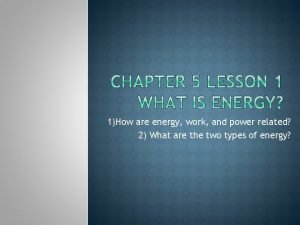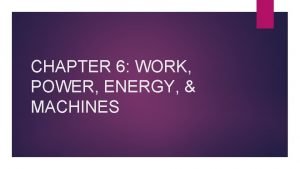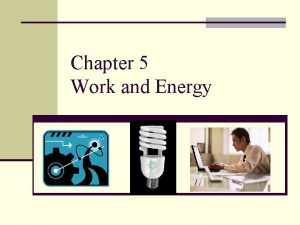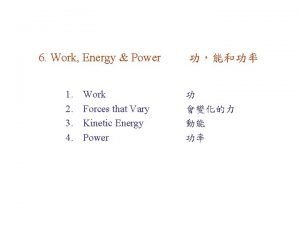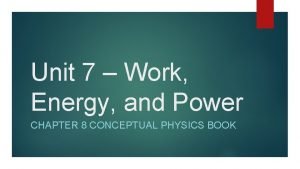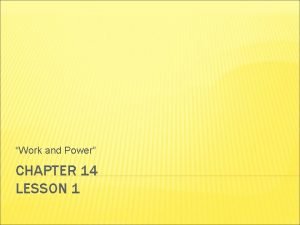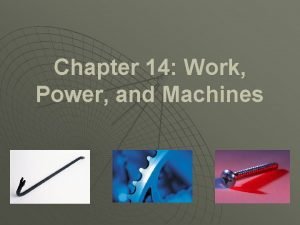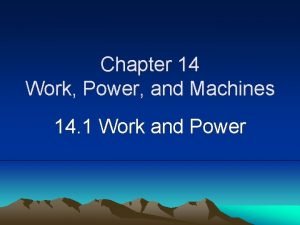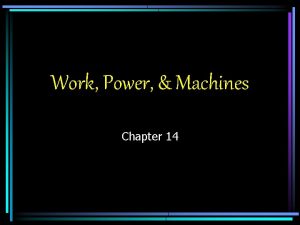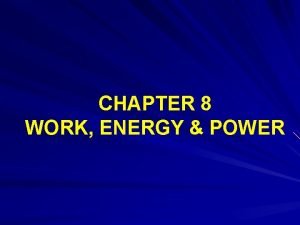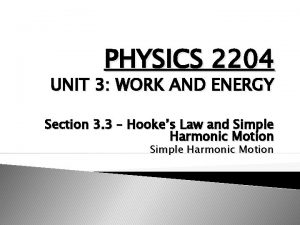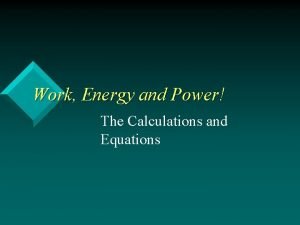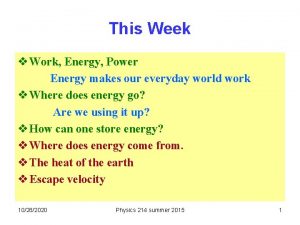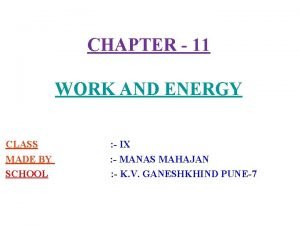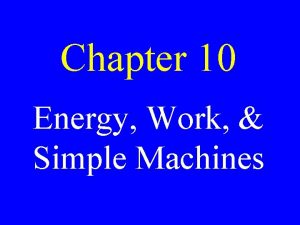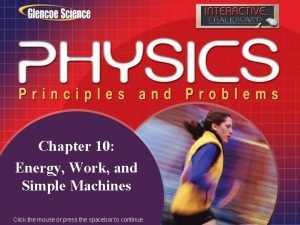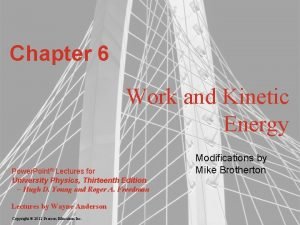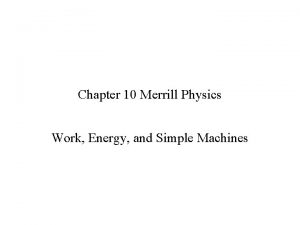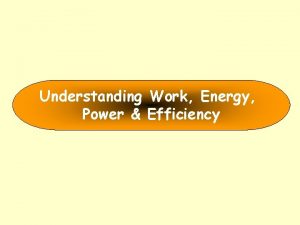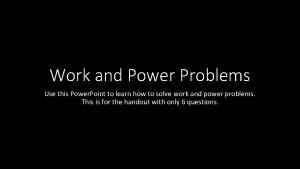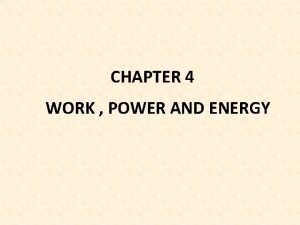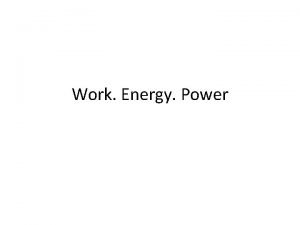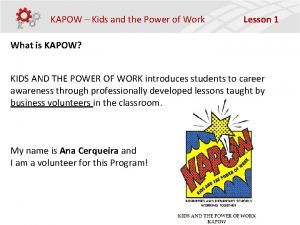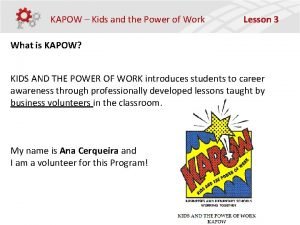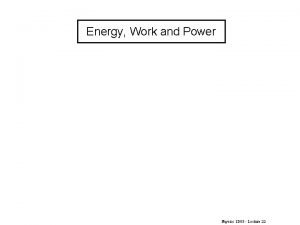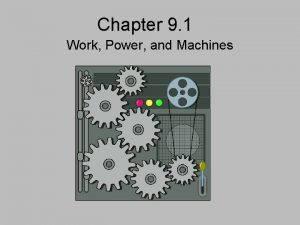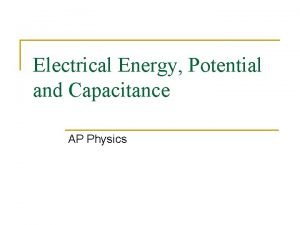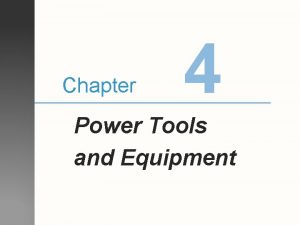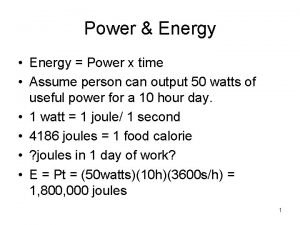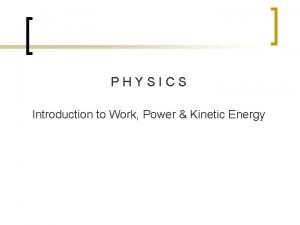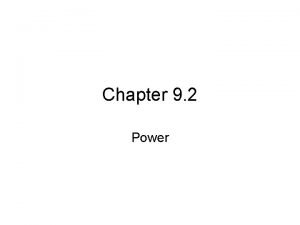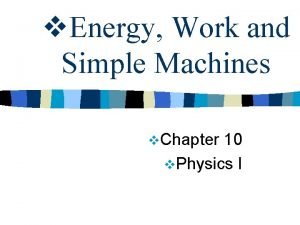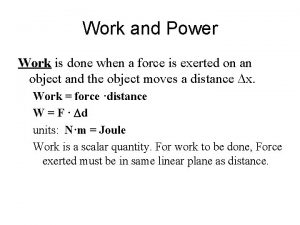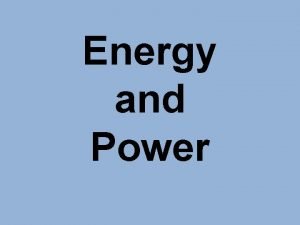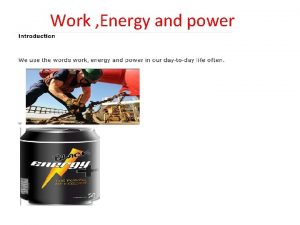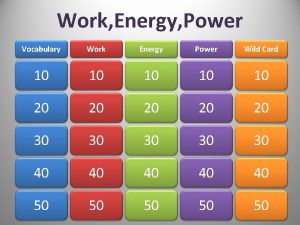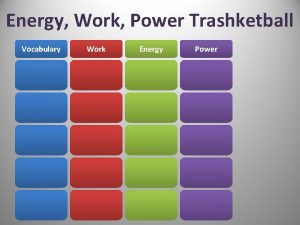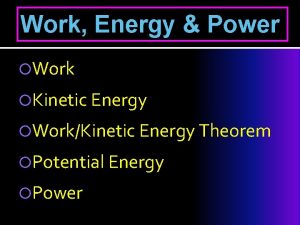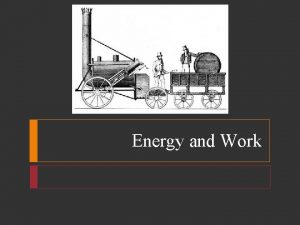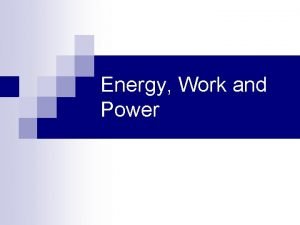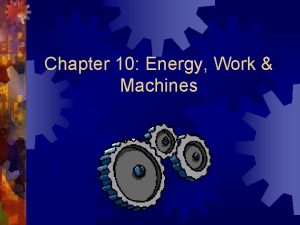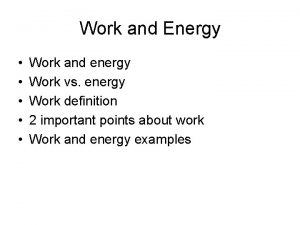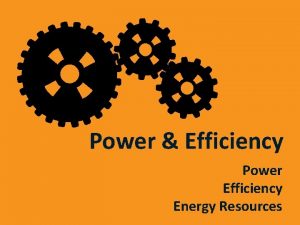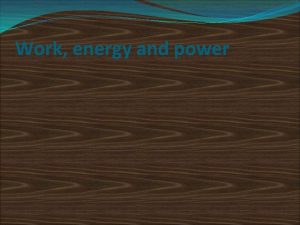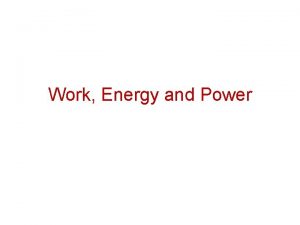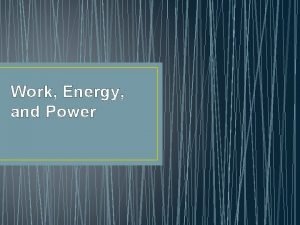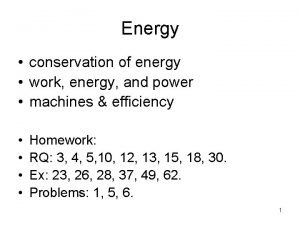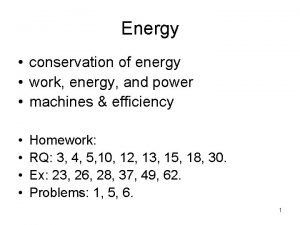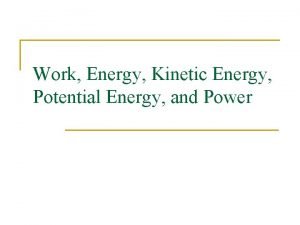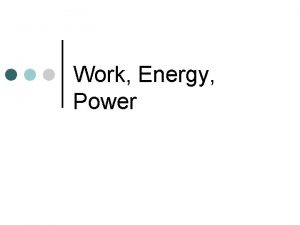Chapter 7 Energy Work and Power Energy Work



























































- Slides: 59

Chapter 7 Energy, Work and Power Energy, Work & Power THEME TWO: NEWTONIAN MECHANICS

Chapter 7 Energy, Work and Power 1. How does our body get energy? From Food. YUMMY!!! 2. Where do cars get energy? From Petrol THEME TWO: NEWTONIAN MECHANICS

Chapter 7 Txbk pg 5 Energy, Work and Power What is Energy? ? ? Definition: Energy is the capacity to do work. Without Energy = no light no electricity no water from tap no bus, no train!!! Without Energy = CLASS WILL BE VERY QUIET!!!!!! can’t talk, can’t walk, can’t breath!!! Without energy, no living, non-living things would work. SO!!!!!! Without energy: Everything dies no life. THEME TWO: NEWTONIAN MECHANICS

Any 7 body or system that can. Work do work Energy, and Power possess Energy. Chapter D = distance moved in the same direction as force applied Energy Defined as: capacity to do WORK Fx. D 1 Joule = 1 Newton meter 1 J = 1 Nm THEME TWO: NEWTONIAN MECHANICS

7 Quiz Chapter Energy, Work and Power Which of the following are forms of energy? a. b. c. d. e. Sound Nuclear Elastic Potential Chemical Potential Joules Is Energy MATTER? NO! Energy does not occupy space and has no mass. THEME TWO: NEWTONIAN MECHANICS

Forms of Energy Chapter 7 Energy, Work and Power kinetic Potential (stored) Gravitational Energies in Action thermal ENERGY light Elastic chemical sound nuclear electrical THEME TWO: NEWTONIAN MECHANICS

Chapter 7 Kinetic Energy, Work and Power Energy a body possess due to its motion: Ek = KE = mv 2 Ek = KE (J) m = mass (kg) v = speed of the body (ms-1) THEME TWO: NEWTONIAN MECHANICS

30 -second Quiz 1 Chapter 7 Energy, Work and Power Usain Bolt holds the Olympic record of 9. 69 s for his 100 -m race. Assuming his mass is 70 kg. What is the kinetic energy KE that he possess? Velocity= KE = 10. 32 m/s = ½ mv 2 = ½ (70) (10. 32)2 = 3727 J = 3730 J (3 s. f. ) THEME TWO: NEWTONIAN MECHANICS

30 -second Quiz 2 Chapter 7 Energy, Work and Power A car with mass of 2000 kg is travelling with a speed of 5 km/h on PIE in a jam. What is its kinetic energy KE? Velocity= 5 km/h = KE = ½ mv 2 = ½ (2000) (1. 389)2 = 1929 J = 1930 J (3 s. f. ) THEME TWO: NEWTONIAN MECHANICS = 1. 389 m/s

Chapter 7 Energy, Work and Power Gravitational Potential Energy a body has due to its position. Ep = PE = mgh Ep = GPE (J) m = mass (kg) g = gravitational field strength (N/m) h = height (m) THEME TWO: NEWTONIAN MECHANICS

30 - second Quiz 3 Chapter 7 Energy, Work and Power A box of mass 20 kg is being pushed up a slope of 15 m long with constant speed of 30 m/s as shown in Figure. a)What is the gain in gravitational potential energy? m = 20 g = 10 N/kg h = 5 m 15 m g 20 k 5 m PE = mgh = 20(10)(5) = 1000 J THEME TWO: NEWTONIAN MECHANICS

Chapter 7 Energy, Work and Power Other Types of Energy • Substances that can be burnt contain chemical potential energy. • Thermal energy of an object = total kinetic energy of the atoms or molecules in the object. *** Heat is the transfer of thermal energy from one body to another. • Molecular kinetic energy is known as internal energy. THEME TWO: NEWTONIAN MECHANICS

Chapter 7 Energy, Work and Power COE THEME TWO: NEWTONIAN MECHANICS

Chapter Work 7 7. 2 Conservation of. Energy, Energy and Power Energy cannot be created or destroyed in any process, but only changes from one form to another or transferred from one body to another Total amount of energy CONSTANT THEME TWO: NEWTONIAN MECHANICS

Chapter 7 Energy, Work and Power Pile-driver for constructing buildings Conservation of Energy BEFORE Gravitational energy THEME TWO: AFTER Kinetic energy Thermal energy and Sound NEWTONIAN MECHANICS Amount of energy no change

Chapter Work 7 Conservation of Energy, Energy • Conversion between PE and KE For example, in the roller coaster, As carriages move downwards, – PE KE. As carriages move upwards, – KE PE Conservation_of_Energy_demolition_ball. wmv THEME TWO: NEWTONIAN MECHANICS and Power

Chapter Work 7 Conservation of Energy, Energy KE = 0, PE = max Both KE + PE and Power KE = 0, PE = max KE = max, PE = 0 Both KE + PE Assume negligible air resistance THEME TWO: NEWTONIAN MECHANICS

15 –second Quiz 4 Chapter 7 Energy, Work and Power Conversion of energy Which one of the following correctly describes the energy conversion that occurs after a bungee jumper jumps from the bridge to the instant when the chord is extended to the maximum? A. EPE KE GPE B. GPE KE EPE C. GPE EPE KE D. KE GPE EPE THEME TWO: NEWTONIAN MECHANICS ans B EPE = elastic PE KE = kinetic energy GPE = gravitational PE

Electricity for Singapore Chapter 7 Energy, Work and Power 2) water turned into steam under intense pressure. steam high 3) Turbine pressure 4) turned by steam Generator steam turbine produces electricity air for combustion exhaust gases Oil or gas condenser water 1) Fuel (oil or natural gas) is. T burnt H E M E T W O : N E W T O N Water I A N M runs ECHA N I C S pipes to boiler through water for cooling

Chapter Work 7 Conservation of Energy, Energy • Worksheet 7 A Q 3 • Text book Pg 127 • Try 7 B Q 3 (3 mins) • Try 7 B Q 4 (3 mins) THEME TWO: NEWTONIAN MECHANICS and Power

Chapter 1 –min Quiz 5 i 7 Energy, Work and Power An acrobat of mass 70 kg jumps down on to the seesaw and lift his partner upward. (Assume negligible air resistance and frictions Take g=10 N kg -1) (i) Calculate the loss of gravitational potential energy when the acrobat touches the see saw. Loss of GPE = mgh = 70 x 10 x 3 = 2100 J THEME TWO: NEWTONIAN MECHANICS 3 m

1 –min Quiz 5 ii Chapter 7 Energy, Work and Power An acrobat of mass 70 kg jumps down on to the seesaw and lift his partner upward. (Assume negligible air resistance and frictions Take g=10 N kg -1) (ii) What is the speed of the acrobat just before touching the see saw? loss in PE = 2100 Gain in KE = loss in PE ½ mv 2 = 2100 ½ x 70 x v 2 = 2100 v THEME TWO: = 7. 75 m/s NEWTONIAN MECHANICS 3 m

1 –min Quiz 5 iii Chapter 7 Energy, Work and Power An acrobat of mass 70 kg jumps down on to the seesaw and lift his partner upward. (Assume negligible air resistance and frictions. Take g=10 N kg -1) (iii) Given that his partner has a mass of 60 kg, how high would he reach? By Conservation of Energy, Amount of energy transferred to partner = 2100 J Gain in PEpartner = Loss in KE mgh = 2100 60 x 10 x h= 2100 h = 3. 5 m THEME TWO: NEWTONIAN MECHANICS 3 m

Chapter 7 Energy, Work and Power Green arrow acceleration g (no change) Blue arrow Velocity (highest at bottom, lowest at top) Brown arrow Spring’s force when stretched (greatest at bottom) THEME TWO: NEWTONIAN MECHANICS

Chapter 7 Energy, Work and Power GPE + KE + Elastic PE (just before max stretch) Elastic PE (max stretch) Green T H E Marrow E T W O : acceleration N E W T O N I Ag. N Blue M E C arrow H A N I C SVelocity Brown arrow Tension

Energy, Work and Power 7 What have we covered so Chapter far? ? Give examples of the various form of energy state the principle of the conservation of energy Give the formula for calculating KE and GPE? apply the relationships for KE and GPE to new situations or to solve related problems Next: Apply relationship Work Done = force x distance moved in direction of force to new situations or to solve related problems THEME TWO: NEWTONIAN MECHANICS

Chapter 7 7. 3 Work. Energy, Work and Power • Work is done when a force produces motion. • Work = force × distance moved in the direction of the force • SI unit: joule (J). W=F×d Initial position F d Final position d must be in the direction that force F is applied THEME TWO: NEWTONIAN MECHANICS

10 -second Quiz 6 Chapter 7 Energy, Work and Power In which of the following cases is work done? A. B. C. D. A person pushing a wooden box forward. A person pushing the wall of a building. A farmer carrying a bag of rice. Two opposing teams of people pulling a tug-of-war rope which is stationary. ans WORK = F x D THEME TWO: NEWTONIAN MECHANICS A

Chapter 7 7. 3 Work. Energy, Work and Power • No work is done unless a force causes an object to move in direction of applied force. No work is done!! Wall did not move even though force is applied THEME TWO: wall NEWTONIAN MECHANICS No work is done!!

Chapter 7 THEME TWO: 7. 3 Work. Energy, Work NEWTONIAN MECHANICS and Power

Chapter 7 7. 3 Work. Energy, Work and Power F d = 1. 5 m Fr = 6 N Initial position On horizontal plane, Force required to move the block Hence, THEME TWO: Final position = Force to overcome friction = 6 N Work Done = F x D (D in direction of F) = 6 x 1. 5 = 9. 0 J NEWTONIAN MECHANICS

Chapter 7 THEME TWO: 7. 3 Work. Energy, Work NEWTONIAN MECHANICS and Power

Chapter Energy, 2 min- Quiz 7 Work 7 and Power An object of mass 20 kg is pulled up a slope of 15 m long with a constant speed. The height of the slope is 5 m. The frictional force between the object and the slope is 30 N. a)What is the work done to overcome friction? b)What is the total work done in pulling the object up the slope? Rope 15 m g 20 k Fr = 30 N THEME TWO: NEWTONIAN MECHANICS 5 m

Chapter Energy, Work 7 2 min- Quiz 7 and Power a)What is the work done to overcome friction? b)What is the total work done in pulling the object up the slope? Rope 15 m a) WD to overcome friction g b) = 30 x 15 20 k Fr = 30 N c) = 450 J b) WD to lift 20 kg up 5 m = mgh = 20 x 10 x 5 = 1000 J Total WD 5 m = WD to overcome friction + WD to lift 20 kg up 5 m = 450 + 1000 = 1450 J THEME TWO: NEWTONIAN MECHANICS

Chapter 7 Work Energy, Work and Power Try 7 B Q 7 ans : a) 2400 J, b) 2400 J (explain) c) KE = 1200 J Those finished, do Q 9: ans a) 0 N, b) 100 N, c) 150 J, e) 50 W Q 11: ans a) 2 ms-2 b) 60 J THEME TWO: NEWTONIAN MECHANICS

Chapter 7 7. 3 Work. Energy, Work and Power • Work is done when a force produces motion. • SI unit: joule (J). W=F×d WD against another force eg, 1. Against gravity pull 2. Against elastic forces 3. Against friction etc THEME TWO: NEWTONIAN MECHANICS WD to change object speed

Chapter 7 7. 3 Work. Energy, Work and Power W=F×d WD against another force 1. against gravitational force on object Final position F h Initial position Force to overcome gravity pull, F = W = mg WD against gravity pull = F x d =Wxh = mgh W = mg THEME TWO: NEWTONIAN MECHANICS

Chapter 7 7. 3 Work. Energy, Work W=F×d WD against another force 2. against elastic forces WD to stretch spring = Fe x extension d Fe THEME TWO: NEWTONIAN MECHANICS and Power

Chapter 7 7. 3 Work. Energy, Work W=F×d WD against another force 3. against friction WD to overcome friction = Fr x d Final position Initial position F Fr d THEME TWO: NEWTONIAN MECHANICS and Power

Chapter 7 7. 3 Work. Energy, Work and Power W=F×d WD to change speed of object Work done on object to change its speed. F Frictionless u m/s d KEi = ½ mv 2 THEME TWO: NEWTONIAN MECHANICS v m/s KEf = ½ mv 2

Chapter 7 7. 3 Work. Energy, Work and Power W=F×d WD against another force eg, 1. Against gravity pull 2. Against elastic forces 3. Against friction etc THEME TWO: NEWTONIAN MECHANICS WD to change object speed

Chapter 1 - min Quiz 8 7 Energy, Work and Power A bullet of mass 50 g was travelling at a speed of 200 ms-1 before striking a sandbag. It travelled through 20 cm of the sandbag before stopping. What was the total resistive force produced by the sandbag? Sand bag Conservation Of Energy, Loss in KE = WD by bullet to move through 20 cm of sandbag ½ mv 2 = F x d ½ (0. 05) (200)2 = F x (0. 20) F = 5000 N THEME TWO: NEWTONIAN MECHANICS

Chapter 7 Work Go through Wksht 7 B Q 11: ans a) 2 ms-2 b) 60 J THEME TWO: NEWTONIAN MECHANICS Energy, Work and Power

Chapter 7 7. 4 Energy, Work Power 70 kg Height risen 10 m Walking leisurely Took 30 secs Chased by dog Took 1 sec Feel more tired running upstairs compared to walking upstairs. THEME TWO: and Power NEWTONIAN MECHANICS

Chapter 7 7. 4 Energy, Work Power and Power Defined as: Rate of work done or Rate of energy conversion Refers to how fast work is done or how fast energy is converted THEME TWO: NEWTONIAN MECHANICS

Chapter 7 70 kg Walking leisurely Took 30 secs WD = F x d = mg x h = 7000 J 7. 4 Energy, Work Power and Power 70 kg Height risen 10 m SAME WD But running took less time then walking! Chased by dog Took 2 secs WD = F x d = mg x h = 7000 J Work is done faster N E W T Oslower N I A N M E C H A N I C Work S THEME TWO:

Chapter 7 7. 4 Energy, Work Power and Power 70 kg Height risen 10 m Walking leisurely Took 30 secs WD = 7000 J SAME WD But running took less time then walking! Work is done slower Chased by dog Took 2 secs WD = 7000 J Work is done faster Running guy has more power! THEME TWO: NEWTONIAN MECHANICS

Chapter 7 7. 4 Energy, Work Power Defined as: Rate of work done or Rate of energy conversion Power = = SI unit : watt (W) • Other units: Joule per second (J s− 1) THEME TWO: NEWTONIAN MECHANICS and Power

Chapter 7 1 - min Quiz 9 Energy, Work and Power A man of mass 60 kg takes 1 min to run up a flight of stairs from X to Y as shown. What is his working power? A. 60 J B. 80 J ANS: C C. 60 W D. 80 W THEME TWO: NEWTONIAN MECHANICS

Chapter 7 1 - min Quiz 9 Energy, Work and Power A man of mass 60 kg takes 1 min to run up a flight of stairs from X to Y as shown. What is his working power? Height h = 6 m, m= 60 kg, t = 1 min = 60 s Gain in GPE = mgh = 60 x 10 x 6 = 3600 J t = 60 s THEME TWO: Power = Δ in Energy = Time 3600 60 = 60 W NEWTONIAN MECHANICS

Chapter 71 - min Quiz 10 Energy, Work and Power A girl weighing 400 N runs up a flight of stairs of vertical height 5 m in 4 s. What is her gain in potential energy and the power developed? Gain in GPE THEME TWO: Power developed A. 1600 J 400 W B. 2000 J 500 W C. 16 000 J 4000 W D. 20 000 J 5000 W NEWTONIAN MECHANICS ANS: B

Chapter 71 - min Quiz 10 Energy, Work and Power A girl weighing 400 N runs up a flight of stairs of vertical height 5 m in 4 s. What is her gain in potential energy and the power developed? Height h = 5 m, W= 400 N, t = 4 s Gain in GPE = mgh = 400 x 5 = 2 000 J t=4 s Power = Δ in Energy = Time THEME TWO: NEWTONIAN MECHANICS 2000 4 = 500 W

Chapter 71 - min Quiz 11 Energy, Work and Power A windmill is used to raise water from a well. The depth of the well is 5 m. The windmill raises 200 kg of water every day. What is the useful power extracted from the wind? Height h = 5 m, mass = 200 kg 0. 116 W WD in raising the water = mgh = 200 x 10 x 5 = 1 x 104 J Everyday t = 24 x 60 = 8. 64 x 104 s Work Done 1 x 104 Power = = Time 8. 64 x 104 = 0. 116 W THEME TWO: NEWTONIAN MECHANICS

Chapter 7 Energy, Work and Power Efficiency Useful Energy Output Efficiency = x 100% Energy Input THEME TWO: NEWTONIAN MECHANICS

Chapter 7 Energy, Work 7. 3 Work and Power • Try Worksheet 7 C • Q 3 ans: a) 200 J, b) 20 W • Q 6 ans: 7. 2 x 105 J, b) 3. 6 x 104 W Those finished can try • Q 8 • Q 4 ans: a) 32 J, b) 4 m/s, c) 1600 N THEME TWO: NEWTONIAN MECHANICS and Power

Chapter 7 Challenge Energy, Work and Power Where did all these energy come from? THEME TWO: NEWTONIAN MECHANICS

Chapter 7 SUMMARY Energy, Work and Power Conservation of Energy Fx. D is defined as ENERGY (J) is defined as the Capacity to do: is in the forms of Others: Thermal Magnetic Nuclear etc is related to PE KE Energy body has due to its state, shape or position GPE = mgh is related to Change in Energy Work Done Time defined as THEME TWO: WORK (J) Energy body has due to its motion KE = ½mv 2 NEWTONIAN MECHANICS OR is defined as POWER (W)

Chapter 7 Energy, Work and Power Green arrow acceleration g (no change) Blue arrow Velocity (highest at bottom, lowest at top) Brown arrow Spring’s force when stretched (greatest at bottom) THEME TWO: NEWTONIAN MECHANICS

Chapter 7 Energy, Work and Power GPE + KE + Elastic PE (just before max stretch) Elastic PE (max stretch) Green T H E Marrow E T W O : acceleration N E W T O N I Ag. N Blue M E C arrow H A N I C SVelocity Brown arrow Tension
 Chapter 4 work and energy section 1 work and machines
Chapter 4 work and energy section 1 work and machines Power triangle diagram
Power triangle diagram Work, power and energy activities
Work, power and energy activities Power definition physics
Power definition physics How are work and power related
How are work and power related Work power energy and machines
Work power energy and machines Definition of work power and energy
Definition of work power and energy Work power
Work power Unit 7 work energy and power answers
Unit 7 work energy and power answers Unit 14 lesson 1 drivers ed
Unit 14 lesson 1 drivers ed Chapter 14 work power and machines
Chapter 14 work power and machines Chapter 14 section 1 work and power
Chapter 14 section 1 work and power Chapter 14 work power and machines
Chapter 14 work power and machines Chapter 8 work and power answers
Chapter 8 work and power answers Physics 03-02 potential energy and conservative forces
Physics 03-02 potential energy and conservative forces 0kei0
0kei0 Work and energy
Work and energy Physics 2204 unit 3: work, power, energy
Physics 2204 unit 3: work, power, energy Work energy power equations
Work energy power equations Work and energy physics
Work and energy physics Chemical potential energy images
Chemical potential energy images Energy energy transfer and general energy analysis
Energy energy transfer and general energy analysis Energy energy transfer and general energy analysis
Energy energy transfer and general energy analysis Chapter 11 work and energy
Chapter 11 work and energy Chapter 10 energy, work and simple machines answer key
Chapter 10 energy, work and simple machines answer key Chapter 10 energy, work and simple machines answer key
Chapter 10 energy, work and simple machines answer key Energy work and simple machines chapter 10 answers
Energy work and simple machines chapter 10 answers Chapter 6 work and energy powerpoint
Chapter 6 work and energy powerpoint Chapter 10 energy work and simple machines answer key
Chapter 10 energy work and simple machines answer key Solar power satellites and microwave power transmission
Solar power satellites and microwave power transmission Actual power
Actual power The dispersive power of a grating
The dispersive power of a grating Work power and efficiency
Work power and efficiency Define work and power
Define work and power Energy definition physics
Energy definition physics How to calculate work and power
How to calculate work and power Lamar gant
Lamar gant Work and power definition
Work and power definition Work energy theorem in words
Work energy theorem in words Kapow kids
Kapow kids Kapow kids
Kapow kids Power physics
Power physics A crate of bananas weighing 3000 n
A crate of bananas weighing 3000 n Flex28024a
Flex28024a Power of a power property
Power of a power property General power rule
General power rule Power angle curve in power system stability
Power angle curve in power system stability Power bi power point
Power bi power point Power delivered vs power absorbed
Power delivered vs power absorbed Chapter 7 energy conservation of energy
Chapter 7 energy conservation of energy Power equation
Power equation Hard work vs smart work presentation
Hard work vs smart work presentation Chapter 10 power tools and shop equipment
Chapter 10 power tools and shop equipment Energy =power x time
Energy =power x time Power versus work
Power versus work Power vs work
Power vs work Work v power
Work v power Power = work/time
Power = work/time Sheila has just arrived at the airport and is dragging
Sheila has just arrived at the airport and is dragging Work vs power
Work vs power




